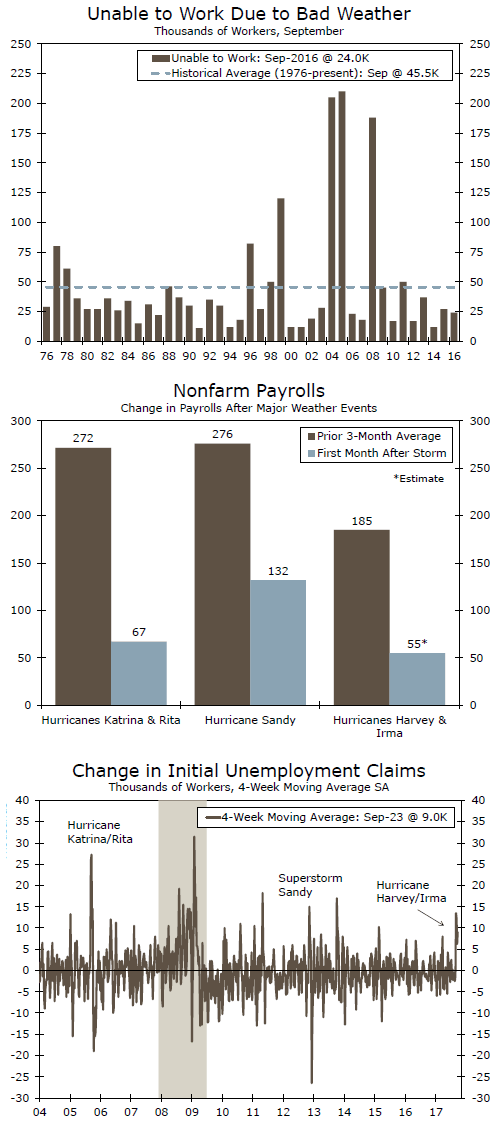Work disruptions due to Hurricanes Harvey and Irma are likely to knock down payroll growth substantially in September. We expect payrolls to rise only 55,000 and for the unemployment rate to edge up temporarily.
Will September Snap the Payroll Streak?
September is set to be a wild month for payroll employment following the landfall of Hurricanes Harvey and Irma. It bears the potential to interrupt the 83 consecutive months of employment growth. The payroll figures stand to be negatively impacted via two channels. First, payrolls are likely to be depressed by work disruptions having delayed routine hiring. Second, employees who didn’t get paid because they weren’t able to work during the pay period covering September 12 will not show up on payrolls. This would have the biggest impact on the one-third of firms with weekly pay periods, particularly in Florida where Irma made landfall during the survey week. The extent to which typically employed workers were not able to work during this period will be illustrated in the household survey (top chart) and leads up to expect a temporary uptick in the unemployment rate to 4.5 percent.
Lessons from Mesdames Katrina and Rita
To get a sense of how big a blow the storms may deal payrolls, we revisit the impact of Hurricanes Katrina and Rita in 2005. The timing of the two storms was similar to that of Harvey and Irma, with Katrina making landfall in late August and Rita coming ashore in September. From a business cycle perspective, Katrina and Rita also struck well into the economy’s expansion, whereas Superstorm Sandy was earlier in the expansion and later in the year.
Following Hurricanes Katrina and Rita, payroll employment was initially reported to have contracted by 35,000 jobs. That marked a 120 percent drop, or 204,000 jobs, from the average over the prior three months. A similar sized drop relative to the current three-month average would result in a decline of 35,000 jobs in September. Applying the more modest 75 percent hit from the revised data for the period equates to payrolls slowing to a gain of 46,000 (middle chart).
Initial jobless claims therefore provide an additional guidepost. Initial claims in September have thus far averaged 278,000 which is 17 percent above August’s average. That compares to a 21 percent rise in September 2005 (bottom chart).
Recent events do not perfectly follow those of 2005. While Houston was never fully evacuated like New Orleans, the metro area hosts a population five times larger. And whereas Rita struck after the survey week in 2005, Irma arrived right at the start of the survey week. Using the initial claims print for the survey week in our usual monthly payrolls model points to a gain of about 152,000 jobs in September. However, after adjusting for hiring delays and some employees not working at any point over the survey week pay period, we have penciled in a 55,000 rise. Of course, payrolls are notoriously difficult to predict in even a typical month, so our forecast comes with a wider confidence interval than usual.













